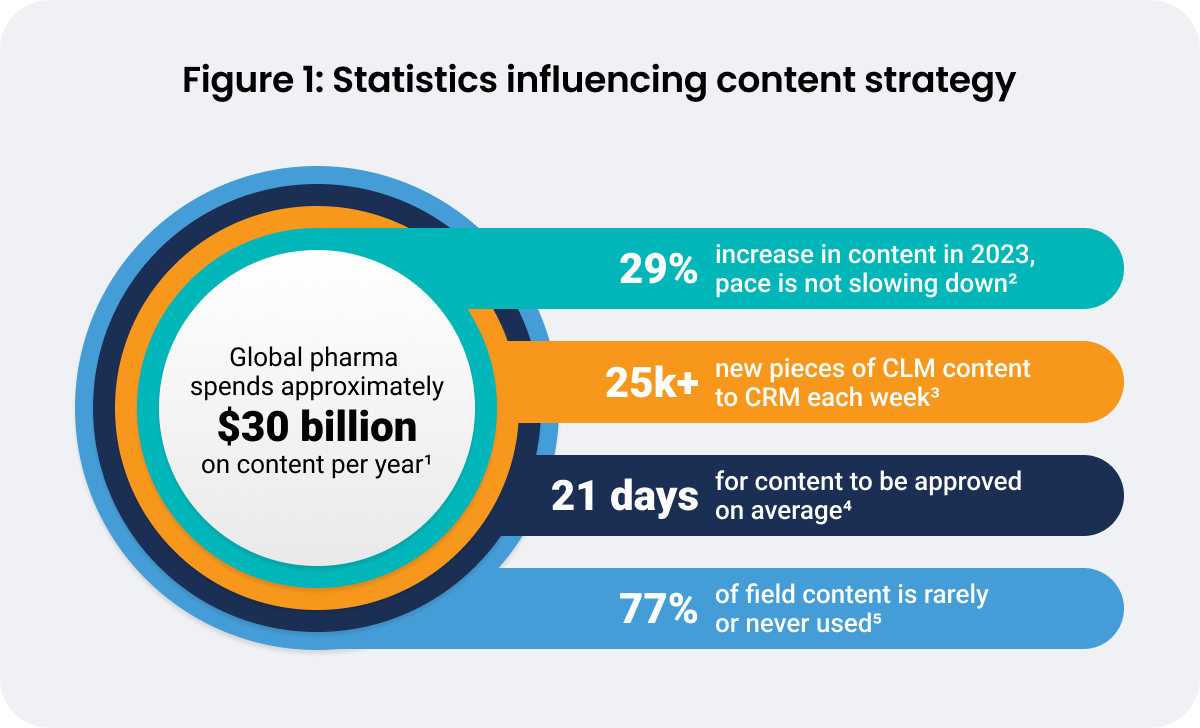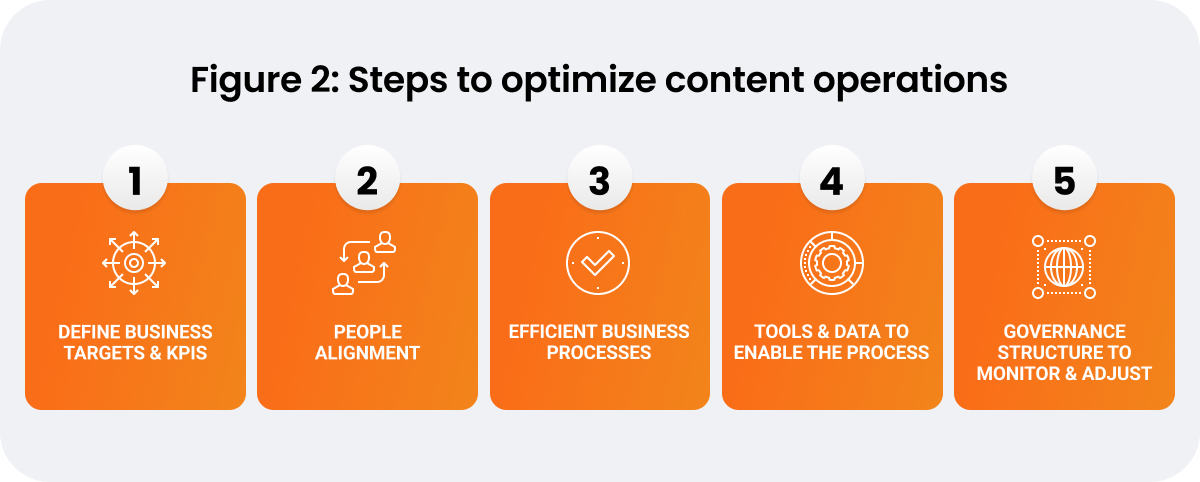Adapt Content Operations to Reach Personalization Goals
AI, modular content, and omnichannel strategies are supporting the efforts to personalize content for healthcare professionals (HCPs). The advancements are also contributing to record-high volume and investment. In 2023, U.S. biopharma commercial content production rose 29% over the prior year as companies collectively added 25,000 new pieces of content per week (Figure 1).

1 Healthgrades 2024 outlook: Pharma Marketing Trends to Watch
2 Veeva Content Benchmark data for U.S., 2023
3 Veeva Vault PromoMats
4 Veeva Pulse Content Metrics, 2023
5 Veeva Pulse Field Trends data, Q4 2023
While personalization creates more content, it also offers the best path to engage HCPs and drive meaningful action for patients. For example, 62% of HCPs said reps can add the most value by understanding their needs and sharing only relevant content to make interactions more insightful.
Efficient operations will set the foundation for supporting HCPs with rapid, relevant, and compliant content at scale. However, content personalization efforts must align with clear business objectives. Otherwise, productivity, for its own sake, could become the goal. Assess your content operations — people, processes, technology, and data — to support personalization efforts and other core business objectives.
Using our five steps (Figure 2) outlined below, determine whether areas of your content operations require revitalization.

1. Set business targets and KPIs

Without the right KPIs — and data to measure them — content teams have no way of knowing if their content is effective. “The most important focus for the industry right now is harnessing data-driven insights to inform the content creation process,” says the senior director and head of commercial digital excellence at a global biopharma. Then, the metrics must tie into business performance objectives — or teams risk losing meaningful value in their data.
Comparing results to industry benchmarks and internal content goals helps identify potential gaps in operational processes. The resulting insights can highlight inefficiencies hindering your ability to deliver personalized content at scale. For example, suppose your review cycles have increased or stalled in the MLR stage. In that case, you can focus on improvements, such as changing the tiers of review in your process, critically reviewing which review members are needed for each content type, or adding concept meetings.
Spend time upfront setting the right business targets and KPIs. Unsure of where to start? A content effectiveness study can help by providing deep knowledge of customers, insight into content data and tagging strategies, or other measurable areas of focus, such as:
- Achieving higher sales uplift per interaction using a selected asset/module
- Improving speed to market by a certain percentage
- Reducing content creation and production spend by a pre-determined amount
- Establishing content reuse definitions and targets
Continuously analyzing performance against targets generates insights you can use to improve future content.
2. Align people with goals

Advancements in content personalization are also disrupting resource allocation models. For example, AI has the potential to help move MLR review from the last stop in the content cycle to a proactive role with greater visibility and input in creating content. Teams could decrease MLR review cycles and cycle times with AI support, accelerating the production of compliant, accurate commercial content — even as volume rises. Likewise, reorienting teams to a modular content approach requires new collaborations and goals. Agencies, commercial operations, IT, regulatory and compliance, and brand teams play a critical role. Advocating for alignment early and quickly is important. Involve each team in the new operating models and targets.
Improve efforts to personalize content, align resources and goals, and remove waste in processes by:
- Documenting and communicating roles and responsibilities toward common goals
- Adjusting the organizational structure as needed to support strategic priorities
- Adopting agile ways of thinking and working
- Ensuring close partnerships with agencies to maintain content quality
Creating relevant, personalized customer content starts by ensuring everyone in the content supply chain understands the business objectives.
3. Conduct efficiency checks on processes

The industry is making incremental efficiency improvements in the content supply chain. For example, high-level data from Veeva Vault PromoMats in 2023 shows that rising content volumes aren’t affecting speed or efficiency: The number of review cycles was down across all markets globally. Among U.S. companies, days in review decreased by more than 25% to 16 days.
However, rapidly rising demands for personalized and relevant content could pressure teams to create unmanageable volumes. Organizations that try to keep pace while using existing resources and processes will reach a tipping point. Some have already begun to innovate and become more efficient by:
- Using a ‘digital factory’ — a centralized team that handles content production
- Adopting a modular approach for content creation, approvals, and reuse
- Automating MLR processes to focus human effort on high-risk content
According to a senior director and head of commercial digital excellence, “Learning how to do more with less, especially in an environment where there is limited funding, resources, and infrastructure, makes it vital to focus on efficiencies in the process.”
His efficiency advice for larger organizations? “Focus less on achieving perfect alignment across stakeholders and avoid unnecessary re-reviews. This overcomplicates workflows and doesn’t guarantee a better outcome,” he adds. Ensure your processes are set up and functioning as intended to achieve targets along the end-to-end content supply chain.
4. Support operations with measurement tools and data

“Companies should think small and act big — leverage the data and content at your disposal and invest in nimble, compliant solutions that will generate new content faster to help differentiate your brand across audiences, channels, and regions,” the senior director and head of commercial digital excellence advises. His company met the need for more personalized content by using modular content, adapting content on the fly, maintaining compliance, and curbing resource use.
For content creation and management, your company might employ tools and strategies, including:
- An agency and production operating model
- AI-assisted content creation
- Modular content and claims
- Standard taxonomy and metadata
In MLR review, the support you need might come from tier-based reviews or AI-assisted quality checks. Finally, an automated content tagging strategy could be your best tool for capturing content effectiveness and ROI. Seamless integration and connectivity between platforms and tools are essential for all stages of the content supply chain.
5. Monitor progress and adjust

A plan to scale content personalization while meeting business objectives requires a guiding vision and sound governance structure. Clearly defined roles and responsibilities, processes, and supporting documentation guide decisions and overall execution and enable you to monitor content effectiveness. Given these insights, teams can make adjustments as needed.
Companies starting their journey to optimize content operations and those in later stages benefit from appointing a steering committee or similar oversight board to maintain focus on their North Star. Once business objectives are in place and teams monitor progress, determine where and when global governance and/or regional or market autonomy make sense. The ‘right’ governance structure will ensure cohesive, above-brand strategic alignment and empower participants with the tools to succeed.
A window of opportunity
Ready to transform your relationship with customers? Optimize your content strategy, keep a line of sight to your content’s ROI, and stay better positioned to deliver the personalized support HCPs need as the market evolves.
What’s your vision for the future content supply chain? Get support for your key content initiatives.